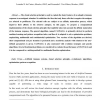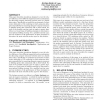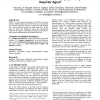61 search results - page 8 / 13 » The use of animation to explain genetic algorithms |
TEC
2002
13 years 7 months ago
2002
The clonal selection principle is used to explain the basic features of an adaptive immune response to an antigenic stimulus. It establishes the idea that only those cells that rec...
BMCBI
2007
13 years 7 months ago
2007
Background: Maximum parsimony phylogenetic tree reconstruction from genetic variation data is a fundamental problem in computational genetics with many practical applications in p...
ATAL
2006
Springer
13 years 11 months ago
2006
Springer
This paper describes simulations designed to test the relative efficiency of two different sequential auction mechanisms for allocating compute resources between users in a shared...
ATAL
2008
Springer
13 years 9 months ago
2008
Springer
DEIRA is a virtual agent commenting on virtual horse races in real time. DEIRA analyses the state of the race, acts emotionally and comments about the situation in a believable an...
ICCV
2003
IEEE
14 years 19 days ago
2003
IEEE
In this paper, we present a generative model for textured motion phenomena, such as falling snow, wavy river and dancing grass, etc. Firstly, we represent an image as a linear sup...



